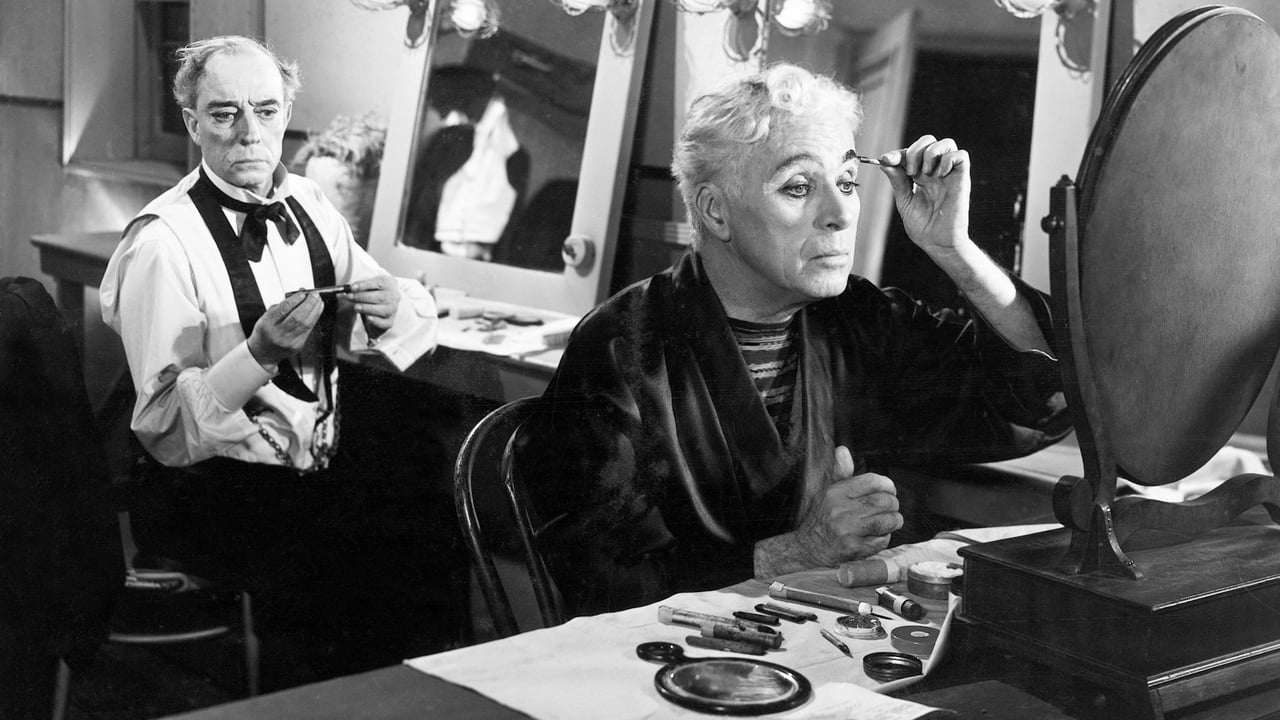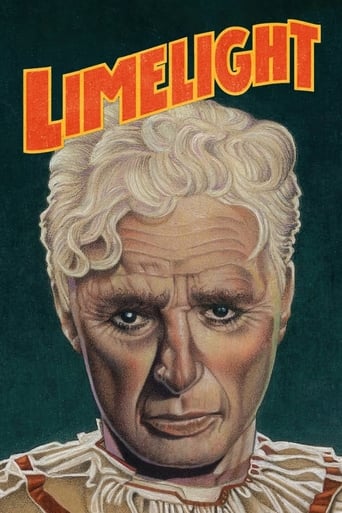

It is a masterpiece with some funny scenes, especially at the end, but mostly because of the tremendous empathy this film carries, conveys and communicates about life, about death, about doing something with the life we have been entrusted with, something positive, something that may serve the community, other people, something that provides love to those who need it, who deserve it. It is impossible to tell the story of this film without in many ways destroying it. We are in London just before the First World War and we are in show business with Charlie Chaplin as an old comedian, Calvero; a young dancer, Thereza who has some stage fright problems that paralyze her legs, and is impersonated by Claire Bloom; and a young composer, Neville enacted by Sydney Chaplin. In Calvero's comeback, he will perform with an old partner of his played by Buster Keaton. The interest of the film is its comic dimension intertwined with the dramatic content, with this dancer who has to be supported and even reconstructed in order to be able to use her legs to perfection. Everyone will remember the slap from Calvero in the wings just seconds before she enters the stage when she is having a sudden paralysis fit caused by stage fright. And the slap works because she is so shocked she cannot even think of her legs anymore.Charlie Chaplin after the Second World War seems to be a lot more humane, empathetic with people, individual people, just as if the war had battered him down tremendously and let him sore in his heart and sad in his mind. The big political and social subjects are more or less kept in the past and now he looks at the mental state of human beings in this world that has to be reconstructed after the five years of absolute folly. Maybe McCarthy and his campaign in Hollywood that forced Charlie Chaplin to move back to Great Britain is softening his critical tone.This final period in Charlie Chaplin's creative life is, just the same as with Picasso, different but yet the same as for imagination, creativity, intensity, human sympathy and compassion. I must say that the scene of flea taming is really funny, though I may prefer the final act with Buster Keaton, the grand piano, and the violin. The satire of classical concerts is so strong and to the point: formality and appearances that have to be saved, kept and protected so much that then the music or the performance becomes stiff and even forbidding.To be seen urgently if you haven't already done so. You will all like Calvero's death on stage, or nearly and you will all think of Molière himself, the greatest comedian of all times and one of the best playwrights, who actually died on stage performing a hypochondriac would-be sick man.Dr. Jacques COULARDEAU
... View MoreBosley Crowther, the New York Times's movie critic at the time of this movie's release, concluded his review with the words "'Limelight' is a very moving film." To my surprise, I agree with him. Although as it was chugging along, I thought it was often verbose, sluggishly paced, only fitfully amusing, and heavy on philosophising, when its famous theme swelled up in the orchestra for the final scene, I burst into tears. It was evident that Chaplin's tale of age giving way to youth had been quietly working on my feelings. You've got to hand it to the guy: after a lifetime making movies, he knew what he was about.One of LIMELIGHT's most fascinating aspects is Chaplin's take on audiences. We see his hero, the vaudevillian Calvero, play his old act twice: first, in a half-empty, emptying theatre; second, before an enthusiastic packed house. The act, though, is the same: there's no sense of a difference between the way Chaplin/Calvero plays it the first time and the second. The early audience decides it doesn't like it, the later audience decides it does. Such haphazard behaviour would be enough to wear anyone down in any relationship. Chaplin powerfully conveys the emotional cost of being at the receiving end of the public's whims.At the opposite stage of her life is Theresa, a young ballet dancer, whose confidence has left her. Even as the flame of Calvero's own self-respect flickers, he is able to ignite Theresa's. The role was a huge break for Claire Bloom, not an actress for whom I have great admiration, but she does OK here, with youth on her side. Elsewhere, there are such delights as Majorie Bennett, Buster Keaton, and Chaplin's own beautiful score.I don't know whether, when all's said and done, it's a masterpiece or not, and maybe it's helpful to be an old person like me to get the best out of it, but, once seen, it's unforgettable.
... View MoreIt's 1914 London. A drunken Calvero (Charles Chaplin) finds Thereza Ambrose (Claire Bloom) passed out in her room from the gas. She had tried to kill herself. The doctor and Calvero take her up to his room where she recuperates. Calvero was once a successful vaudeville clown but now he's all washed up. His agent gets him a show but it goes horribly. Six months later, she has regained her confidence as a ballet dancer. She's in love with Calvero despite his drunkenness. She's reunited with composer Neville (Sydney Earl Chaplin) whom she had a crush on as a shopgirl. Calvero continues to dismiss Thereza's marriage proposals.I find Chaplin too stridden to be either romantic or as a kindly mentor. He's a little off-putting and his comedy isn't working that well. He's more of a physical comedian. When the audience walks out on him, it seems very autobiographical. This works a little better as a drama. Chaplin's son is a bit stiff. That role needs somebody better. The biggest missed opportunity is Chaplin's performances on stage. It seems like a great time to reintroduce the tramp. At this point, Chaplin works better as a man passed his prime and that would be powerful. This movie asks too much from him. It's also fun to see Buster Keaton share the same screen with Chaplin and they have some good scenes together. Imagine if they did their act as older version of their acts.
... View MoreEver since "The Kid" the British born Charles Chaplin had been a monument of American silent film making. Despite his refusal to concede to the inevitable wind of change in the business he stubbornly continued to make silents in the time of sound. But he finally had to say farewell to the little tramp - only to resurrect another version of him in the essential and daring satire "The Great Dictator". With it Chaplin arrived in the new area, safe and with sound, genius undiminished. "Limelight", made years later in 1952, however marks a crossroads for Chaplin and practically forestalls his swansong. Similar to his "Dictator" he was ahead of his time when he made the picture as it was the last film he managed to produce in the US before he became an unwanted person under the suspicion of supporting un-American intentions..."Limelight" in many ways tells Chaplin's own story about a former vaudeville star now on the path of decline, where the full weight of reality catches up with him. It's a melancholic film about the clown Calvero's struggle, but also one of hope and inspiration when he rescues a suicidal ballet dancer and helps her to regain new courage to face life despite he himself is in a downward spiral. But things are not as simply cut as they seem and triumph and tragedy are closely linked... Together with Chaplin stars an impressive Claire Bloom as the girl saved by Calvero, Nigel "Dr. Watson" Bruce as the impresario harking back to his days as Sherlock Holmes assistant, Chaplin's own son Sydney and last but not least the great former rival and by now completely broke Buster Keaton. The latter in a minor, but pivotal, crucially transcending role as assistant on the side of the great clown. All those autobiographical references are evident and become even stronger when we know that recognition for this masterpiece came only more than 20 years after the release of the film in Europe in form of an US Academy Oscar for best score, which - of course - Chaplin co-wrote. To speak with Calavero's own words: "Limelight" is a story about "the enigma of the heart and the mind"... As was Chaplin: a restlessly creative enigma with heart and mind.
... View More